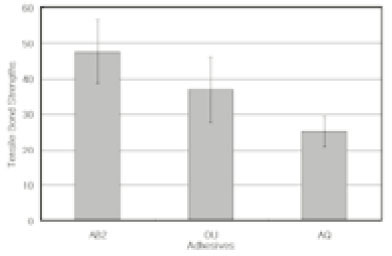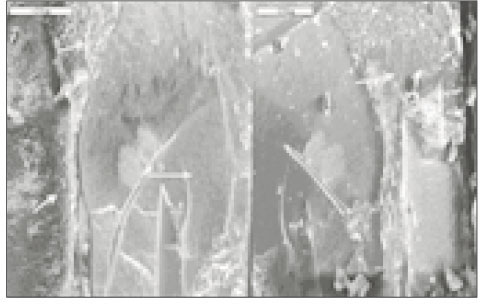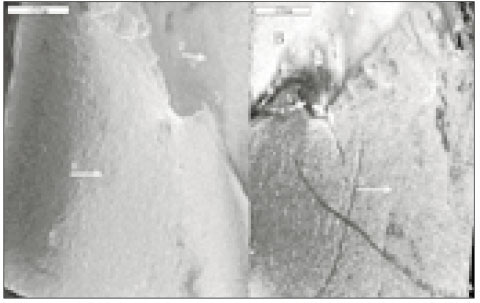References
1. Buonocore M. A simple method of increasing the adhesion of acrylic filling materials to enamel surfaces. J Dent Res 1995. 34849–853.
2. Pashley DH, Carvalho RM, Sano H, Nakajima M, Yoshiyama M, Shono Y, Fernandes CA, Tay F. The microtensile bond test : a review. J Adhes Dent 1999. 1(4)299–309.
3. Schreiner RF, Chappell RP, Glaros AG, Eick JD. Microtensile testing of dentin adhesives. Dent Mater 1998. 06. 14194–201.
4. Chappell R, Schreiner R, Glaros A, Eixk J. Pilot study to determine sample size for micro-tensile testing. J Dent Res 1997. 7638. Abstr. no. 193.
5. Sano H, Sonoda H, Shono J, Takatsu T, Ciucchi B, Carvalho RM, Pashley DH. Relationship between suface area for adhesion and tensile bond strength -Evaluation of a microtensile bond test. Dent Mater 1994. 10236–240.
6. Sano H, Ciucchi B, Matthews WG, Russell CM, Pashley DH. Tensile properties of mineralized and demineralized human and bovine dentin. J Dent Res 1994. 731205–1211.
7. Sano H, Takatsu T, Ciucchi B, Russell CM, Pashley DH. Tensile properties of resin-infiltrated demineralized human dentin. J Dent Res 1995. 741093–1102.
8. Sano H, Yoshikawa T, Pereira PNR, Kanemura N, Morigami M, Tagami J, Pashley DH. Long-term durability of dentin bonds made with a self-etching primer in vivo. J Dent Res 1999. 78906–911.
9. Schreiner RF, Chappell RP, Glaros AG, Eick JD. Microtensile testing of dentin adhesives. Dent Mater 1998. 14194–202.
10. Shono Y, Terashita M, Pashley EL, Brewer PD, Pashley DH. Effects of surface area on resin-enamel tensile bond strength. Dent Mater 1997. 13290–296.
11. Zheng L, Pereira PN, Nakajima M, Sano H, Tagami J. Relationship between adhesive thickness and microtensile bond strength. Oper Dent 001. Jan-Feb. 26(1)97–104.
12. Samsri S, Van Noort R. Do dentin bond strength tests serve a useful purpose? J Adhes Dent 1999. 157–67.
13. Van Noort R, Noroozi S, Howard IC, Cardew G. A critique of bond strength measurements. J Dent 1989. 1761–67.
14. Versluis A, Tantbirojn D, Douglas WH. Why do shear bond tests pull out dentin. J Dent Res 1997. 761298–1307.
15. Pashey DH, Samo H, Ciucchi B, Yoshiyama M, Carvalho RM. Adhesion testing of dentin bonding agents : A Review. Dent Mater 1995. 11117–125.
16. Cardoso PEC, Braga RR, Carrilho MRO. Evaluation of microtensile, shear and tensile tests determining the bond strength of three adhesive systems. Dent Mater 1999. 14394–398.
17. Nakabayashi N, Kojima K, Masuhara E. The promotion of adhesion by the infiltration of monomers into tooth states. J Biomed Mater Res 1982. 16265–273.
18. Gwinnett AJ, Matsui A. A study of enamel adhesives The Physical relationship between enamel and adhesive. Arch Oral Biol 1967. 121615–1620.
19. Buonocore MG, Matsui A, Gwinnett AJ. Penetration of resin dental materials into enamel surfaces with reference to bonding. Arch Oral Biol 1968. 1361–70.
20. Simmelink JW, Nygaard VK, Scott DB. Penetration of resins in0to partially demineralized enamel in vivo. Arch Oral Biol 1974. 18435–439.
21. Gwinnet AJ, Ripa LW. Penetration of pit and fissure sealants into conditioned enamel in vivo. Arch Oral Biol 1973. 18435–439.
22. Wakabayashi H, Kondo Y, Suzuki K, Yatani H, Ymashita A. Effect of dissolution of collagen on adhesion to dentin. Int J Prosthodont 1994. 7302–306.
23. Kanca J. Wet bond. Effect of drying tome and distance. Am J Dent 1996. 9273–276.
24. Gwinnet AG, Tay FR, Wei SHY. In : Shino M, Maeda T, Suda H, Takayashi K, eds. Bridging the gap between overly dry and overwet bonding phenomenon of dentin hybridization and tubular seal. Dentin/pulp complex 1996. Tokyo: Quintessence; 359–363.
25. Suzuki M, Kato H, Wakumoto S. Vibrational analysis by Raman spectroscopy of the interface between dental adhesive resin and dentin. J Dent Res 1991. 701092–1097.
26. Sano H, Shono t, Hosoda H. Microporous dentin zone beneath resin-impregnated layer. Oper Dent 1994. 1959–64.
27. Pashley DH, Carvalho RM. Dentin permeability and dentine adhesion. J Dent 1997. 25355–372.
28. Tay FR, Pashley DH. Aggressiveness of contemporary self-etching systems I: Depth of penetration beyond dentin smear layers. Dent Mater 2001. 17296–308.
29. Nakabayashi N, Saimi Y. Bonding to intact dentin. J Dent Res 1996. 751706–1715.
30. Ferrari M, Mannocci F, Vichi A, Davidson CL. Effect of two etching times on the sealing ability of Clearfil Liner Bond 2 in Class V reatorations. Am J Dent 1997. 1066–70.
31. Watanable I, Nakabayashi N, Pashley DH. Bonding to ground dentin by a phenyl-P self-etching primer. J Dent Res 1994. 731212–1220.
32. Hume WR. Influence of dentine on the pulpward release of eugenol or acids from restorative materials. J Oral Rehabil 1994. 21469–473.
33. Watanabe I, Nakabayashi N, Saimi Y. Effect of smear layer on bonding to ground dentin-relationship between grinding condition and tensile bond strength. Dent Mater J 1994. 13101–108.
34. Toida T, Watanabe A, Nakabayashi N. Effect of smear layer on bonding to dentin prepared with bur. Dent Mater J 1995. 14109–116.
35. Miyasaka K, Nakabayashi N. Combination of EDTA conditioner and Phenyl-P/HEMA self-etching primer for bonding to dentin. Dental Materials 1999. 15153–157.
36. Eliades G, Vougiouklakis G, Palaghias G. Heterogeneous distribution of single-bottle adhesive monomers in th resin-dentin interdiffusion zone. Dent Mater 2001. 17277–288.
37. Sano H, Uno S, Inous S. In : Sano H, Uno S, Inous S, eds. Clinical considerations of dentin adhesion. Modern trends in adhesive dentistry 1998. Osaka: Kuraray; 1–13.
38. Sano H, Takatsu T, Ciucchi B, Horner JA, Natthews WG, Pashley DH. Nanoleakage: leakage within the hybrid layer. Oper Dent 1995. 2018–25.
39. Sano H, Shono T, Takatsu T, Hosoda H. Microporous dentin zone beneath resin-impregnated layer. Oper Dent 1994. 1959–64.
40. Sano H, Yoshiyama M, Ebisu S, Burrow MF, Takatsu T, Ciucchi B, Carvalho R, Pashley DH. Comparative SEM and TEM observations of nonoleakage within the hybrid layer. Oper Dent 1995. 20160–170.
41. Eick JD, Robinson SJ, Chappell RP, Cobb CM, Spencer P. The dentinal surface : its influence on dentinal adhesion III. Quintessence Int 1993. 24(8)571–574.




















